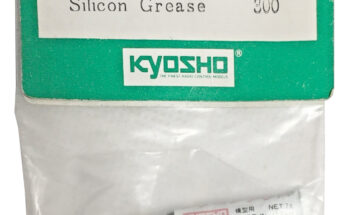Every application needs its own type. Let’s dig a bit deeper into the range.
Grease and lubricants
Many seem to use the Tamiya range, so I am using the terminology used mostly on those.
Ceramic grease: for plastic gears, axles, (non-ball) bearings. contains boron nitride. Nylon gears (often used in Tamiya kits) don’t actually need lubrication but a small amount doesn’t hurt. This grease is thin and doesn’t add too much resistance to the gear action as long as you apply a very small amount. Just making the surface shiny with a small paint brush is enough. It can dry out over time and isn’t that good in the cold.
Cera grease HG: ‘high grade’ ceramic grease with more consistent boron nitride particle size. Also used on metal-plastic.
Molybdenum grease: lithium grease with added molybdenum disulfide. Used for metal-metal contact. It’s slightly sticky and coats the surfaces with the moly. Used on RC cars metal-to-metal gears or metal-to-metal connections like splined driveshaft into a drive gear. It does have abrasive properties in some circumstances and shouldn’t be used on eg. aluminium gears (like the tamiya pinions and some idler gears) or ball bearings. It’s not friendly on plastic and rubber.
Ball diff grease: silicon grease used to offer lubrication to diff balls in their housings, but gets completely dispersed on the contact points between the balls and the plates, offering a combination of lubrication as well as bite / grip between the balls and the diff plates.
Diff plate grease: thick version of ball diff grease, used between diff plate and outdrive.
AW Grease: anti-wear grease. It’s a sticky, thick type of grease that doesn’t fling off gears easily, so it’s often used in gear differentials to provide some ‘lock’ (like in a limited slip differential) to the diff. It adds drag to the parts that are interacting, so it’s often used on parts where drag is not a big problem (eg. through leverage effect, it used to be recommended in the Tamiya kits for CV joints). If you want a lot of lock, you should consider the Tamiya Diff Putty. Note that on full metal gear diffs (gears, shafts, housing) molybdenum grease can be used as well but it will not add a lot of ‘lock’ to the diff.
Differential gear grease: Kyosho has brought this on the market. It is a gear diff grease available in different viscosities, offering more control than the AW Grease.
VG Joint/Cup grease: less thick than AWG but still stays in place. It’s used for on-road only as off-road situations bring too much dirt which gets trapped into the lubricants.
Damper grease: like associated ‘green slime’, used for coating damper seals / o-rings to make them move freely and smoothly without negatively (often even positively) affecting sealing action.
Ball bearing oil: very thin grease intended mainly as rust protection. This oil is very thin so that it adds the least drag possible to the ball bearings. I often rinse new bearings out with a solvent / degreaser (methylated spirits, alcohol,…) and then add a drop of bearing oil or sewing machine oil to them. You will notice the difference when you let them spin freely.
Thrust bearing (black) grease: only for use on thrust bearing balls.
Switch lubricant: a lubricant for mechanically moving / sliding connections where electricity flows through. Like on mechanical speed controllers. It will not become liquid due to heat and will prevent arching while also protecting the contacts from corrosion and smoothing the action. Switch lubricant is not conductive to electricity.
Silicon oil
There are two main uses for silicon oil.
Damper oil: thicker oil slows the action of the spring, in combination with the number of holes and size of the holes in the damper pistons. Typically comes in weights or viscosities from 100 cst to 750 cst or 10 to 75 wt. Note that conversion values to ‘wt’ aren’t an exact match between brands, cst is the official measure. Measurements in ‘wt’ actually refers to the SAE scale of motor oil, which has a wide variation depending on eg. temperature.
Diff oil: the thicker version of damper oil, typically ranging from 2.000 to 1.000.000 cst. The thicker the oil (and the more oil) you add to a gear diff, the more ‘lock’ it has. Note that the gear diff should be meant for silicon oil application and oil seals should be in place to prevent leaking.
Thread lock
Meant to prevent screws coming loose., tread lock is mostly an anaerobic gel, meaning it will dry in the absence of air. It has a high shear strength, meaning it will prevent surfaces from moving parallel to each other. It often has a low tensile strength (which is how hard it is to move the surfaces away from each other).
Thread lock comes in different strengths, and mostly a low strength type is used for RC applications.
It must be noted that most if not all actual anaerobic thread lock will only work on metal-to-metal applicatino and is not safe for plastics. The compounds in the thread lock can make the plastic glassy, rendering it brittle and very prone to cracking. ‘Thread lock’ indicated fluids for plastics are mostly just cyano-acrylate (CA) glues.
The Tamiya red Anaerobic Gel Thread Lock is a low strength thread lock. The Tamiya Liquid Thread Lock is unfortunately no longer being produced, I remember it being a stronger product and easier to apply.


